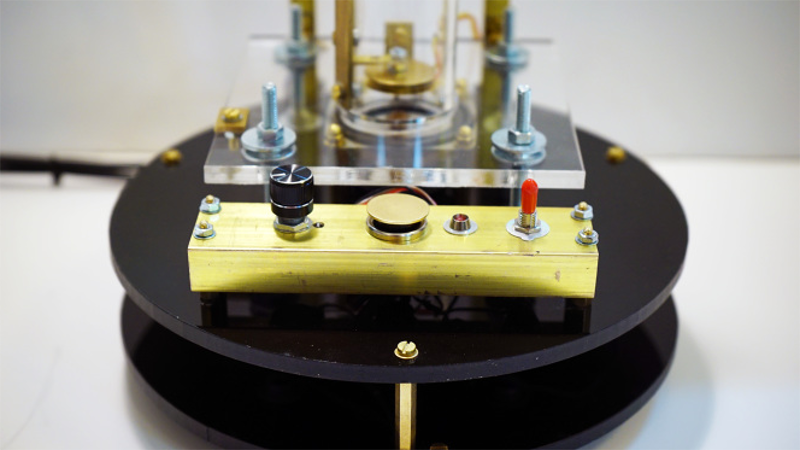When [::vtol::] wants to generate random numbers he doesn’t simply type rand() into his Arduino IDE, no, he builds a piece of art. It all starts with a knob, presumably connected to a potentiometer, which sets a frequency. An Arduino UNO takes the reading and generates a tone for an upward-facing speaker. A tiny ball bounces on that speaker where it occasionally collides with a piezoelectric element. The intervals between collisions become our sufficiently random number.
The generated number travels up the Rube Goldberg-esque machine to an LCD mounted at the top where a word, corresponding to our generated number, is displayed. As long as the button is held, a tone will continue to sound and words will be generated so poetry pours forth.
If this take on beat poetry doesn’t suit you, the construction of the Ball-O-Bol has an aesthetic quality that’s eye-catching, whereas projects like his Tape-Head Robot That Listens to the Floor and 8-Bit Digital Photo Gun showed the electronic guts front and center with their own appeal.
















One would presume that it must be something akin to a normally distributed ‘random number’ whose (mu, sigma) are determined by the frequency set..? That is, you wouldn’t expect that the shortest or longest mechanically possible intervals are as abundant as compared with something in the middle.
I agree. I doubt this is a really good random number generator.
Nobody, except the OP, ever said this was intended to be a random number generator.
If you look at this guy http://vtol.cc/filter/works ,i think he is really good at what he does
if this was in any way serious he would have made comparisons to other methods. the author offers no explanation or any theory whatsoever, just some “artistic” motivation. nothing to learn or see here.
Hopefully the remarks above are some form of “engineer performance art”, where we are challenging stereotypes by leaning [i]way[/i] into them.
It’s a speculative art piece .. it’s not supposed to be a “good random number generator” and it’s not intended to be “comparable to other methods”. It’s kinetic art that invites questions about “randomness” and “the nature of creativity” and “laser cut acrylic” and that kind of thing.
I actually would be interested in seeing a long sequence of inter-event times. My guess is that the arrival intervals are (approximately) exponentially distributed.
“creating” random numbers is “an art” by itself – as in “it is really, really hard to do, if you are striving for REALLY random numbers that remain random in the long run”.
I doubt very much that this setup matches any expectations for “randomness”. Therefor it probably is just about “art”. Which is fine, there are people who consider art a meaning by itself. Other people believe in Gods. They should all have their place in our world.
However, the article suggests that this “artwork” creates sufficiently random numbers – and if that is the PURPOSE of the build, then I am quite sure the critics above have a lot more weight to them than some “random defence of the project for art purpose”.
Artists: MAKE UP YOUR MINDS. Do you want to create art (and accept that people consider the result meaningless) or do you want to create something “purposeful” (and accept that critic towards the usability or viability of the result is sound)?
Or do you always expect that a note reading “because this is art” justifies ANY flaw in design?
This would create a bounded moderately normal distribution of numbers as most hardware-based methods do.
If you want something to truly aspire to (and possibly to replicate with Arduinos just because you can), look no farther than Silicon Graphics’ “Lavarand” Lava Lamp Random Number Generator from the 1990s. Yes, really.
Description: https://web.archive.org/web/19980521144845/http://lavarand.sgi.com:80/cgi-bin/how.cgi
Patent: https://www.google.com/patents/US5732138
Or if you like to live dangerously, there’s radioactive decay: http://www.fourmilab.ch/hotbits which is still operating.
I’m not sure if it’s running a bit more slowly now than when it was first put up ;-)
Ooh, lava lamp .. awesome! Thanks for that link.
your an ugly person sorry but you are IMO